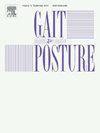Effects of foot orthoses on lower extremity joint kinematics and kinetics in runners with asymptomatic flatfeet: A systematic review and meta-analysis
IF 2.2
3区 医学
Q3 NEUROSCIENCES
引用次数: 0
Abstract
Background
Foot orthoses (FO) are commonly prescribed by clinicians to manage foot and ankle conditions and improve biomechanical function.
Research question
Are there any potential kinematic and kinetic effects of FO on individuals with asymptomatic flatfeet during running?
Methods
The database search from inception to September 2024, including PubMed, Scopus, Web of Science, Embase, ProQuest, Cochrane, and CINAHL, identified 12 studies including 18 different orthotic interventions. These included FO with either arch-support-only or arch-support with medial-side posts. The methodological quality and risk of bias were assessed using ROBINS-I index. Primary outcome measures were joint angles and moments of midfoot/arch, ankle, and knee.
Results
Our meta-analysis revealed non-significant changes with the arch-support-only FO. However, random effects analysis indicated that arch-support FO with rearfoot and forefoot medial posts significantly decreased standardized mean difference (SMD) in peak ankle eversion angles (SMD=-0.41, 95 %CI[-0.78 to −0.04]), peak ankle invertor moments (SMD=-0.51, 95 %CI[-0.97 to −0.05]), and Achilles tendon loading rates (SMD=-0.94, 95 %CI[-1.78 to −0.09]) during running.
Significance
The findings of this meta-analysis suggest that arch-support FO with strategically placed medial posts may enhance stability and alleviate internal loading on the foot-ankle complex during running in individuals with asymptomatic flatfeet. Specifically, FO with medial posts at both the rearfoot and forefoot reduced peak ankle eversion angle, although this is based on only six studies. FO with such features may also decrease loading on the invertor muscles and Achilles tendon during running in individuals with asymptomatic flatfeet. Further research is needed to confirm these findings in larger populations.
足部矫形器对无症状扁平足跑步者下肢关节运动学和动力学的影响:系统回顾和荟萃分析
足部矫形器(FO)通常被临床医生用于治疗足部和踝关节状况并改善生物力学功能。研究问题:在跑步过程中,FO对无症状扁平足患者有潜在的运动学和动力学影响吗?方法检索PubMed、Scopus、Web of Science、Embase、ProQuest、Cochrane、CINAHL等数据库,检索到12项研究,包括18种不同的矫形干预措施。这些包括FO与拱支持或拱支持与中间侧柱。采用ROBINS-I指数评价方法学质量和偏倚风险。主要结局指标是关节角度和中足/足弓、踝关节和膝关节的力矩。结果我们的荟萃分析显示,只支持弓的FO没有显著变化。然而,随机效应分析表明,后脚和前脚内侧柱的足弓支撑FO显著降低了跑步过程中峰值踝关节外翻角的标准化平均差(SMD=-0.41, 95 %CI[-0.78至- 0.04])、峰值踝关节内翻力矩(SMD=-0.51, 95 %CI[-0.97至- 0.05])和跟腱加载率(SMD=-0.94, 95 %CI[-1.78至- 0.09])。这项荟萃分析的结果表明,在无症状扁平足患者的跑步过程中,有策略地放置内侧立柱的足弓支持FO可以增强稳定性并减轻足-踝关节复合物的内部负荷。具体来说,在后脚和前脚都有内侧支点的前跖骨可以减少踝关节外翻角,尽管这只基于六项研究。具有这些特征的FO也可以减少无症状扁平足患者跑步时对内翻肌和跟腱的负荷。需要进一步的研究来在更大的人群中证实这些发现。
本文章由计算机程序翻译,如有差异,请以英文原文为准。
求助全文
约1分钟内获得全文
求助全文
来源期刊

Gait & posture
医学-神经科学
CiteScore
4.70
自引率
12.50%
发文量
616
审稿时长
6 months
期刊介绍:
Gait & Posture is a vehicle for the publication of up-to-date basic and clinical research on all aspects of locomotion and balance.
The topics covered include: Techniques for the measurement of gait and posture, and the standardization of results presentation; Studies of normal and pathological gait; Treatment of gait and postural abnormalities; Biomechanical and theoretical approaches to gait and posture; Mathematical models of joint and muscle mechanics; Neurological and musculoskeletal function in gait and posture; The evolution of upright posture and bipedal locomotion; Adaptations of carrying loads, walking on uneven surfaces, climbing stairs etc; spinal biomechanics only if they are directly related to gait and/or posture and are of general interest to our readers; The effect of aging and development on gait and posture; Psychological and cultural aspects of gait; Patient education.
 求助内容:
求助内容: 应助结果提醒方式:
应助结果提醒方式:


